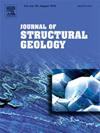The Baiyangping vein-type polymetallic mineralization as a response to shear zone development and block rotation in SE Tibetan Plateau
IF 2.6
2区 地球科学
Q2 GEOSCIENCES, MULTIDISCIPLINARY
引用次数: 0
Abstract
The Baiyangping district is located in the northern Lanping Basin, SE Tibetan plateau. This area has undergone 80°–90° clockwise rotation around the Eastern Himalayan Syntaxis during the Oligocene–Early Miocene. Three major shear zones (Gaoligong, Biluoxueshan–Chongshan, and Ailao Shan–Red River) define the regional scale architecture that hosts the Baiyangping district. Several N-S structures parallel to the Biluoxueshan-Chongshan shear zone in the Baiyangping district underwent simple shear during ore formation. The Baiyangping district orebodies consist of two conjugate sets of veins (WNW-and NE-striking) and bedding-parallel veins. Block rotation occurred along the main shear zones, and conjugate veins occupied Riedel shear fractures (R and R′). Dilation occurred under progressive simple shear as the veins rotated. Ore-forming fluids migrated upwards into the dilating zones, and interacted with host rocks which buffered the fluids, increasing δ13CPDB values in higher carbon content host rocks, and then sealing the space. Repeated cycles of dilation and cementation formed the orebodies of the Baiyangping district. This study highlights how block rotation can be linked to structures that control ore vein formation at the outcrop scale within obliquely convergent orogenic belts.
青藏高原东南部剪切带发育和块体旋转作用下的白杨坪矿脉型多金属矿成矿作用
白杨坪地区位于青藏高原东南部兰坪盆地北部。在渐新世-早中新世期间,该地区绕东喜马拉雅山系顺时针旋转了 80°-90°。三个主要剪切带(高黎贡、碧罗雪山-崇山和隘老山-红河)确定了白杨坪地区的区域尺度构造。白杨坪地区与毗卢雪山-崇山剪切带平行的几个 N-S 构造在矿石形成过程中经历了简单的剪切作用。白杨坪地区的矿体由两组共轭脉(WNW-NE-Striking)和层理平行脉组成。矿块沿主剪切带旋转,共轭矿脉占据了里德尔剪切断裂(R 和 R′)。随着矿脉的旋转,矿脉在渐进的简单剪切作用下发生扩张。成矿流体向上迁移到扩张带,并与主岩相互作用,主岩对流体起缓冲作用,使含碳量较高的主岩中的δ13CPDB值增加,然后封闭了空间。扩张和胶结的反复循环形成了白杨坪地区的矿体。这项研究强调了在斜向汇聚造山带的露头尺度上,块体旋转如何与控制矿脉形成的构造相联系。
本文章由计算机程序翻译,如有差异,请以英文原文为准。
求助全文
约1分钟内获得全文
求助全文
来源期刊

Journal of Structural Geology
地学-地球科学综合
CiteScore
6.00
自引率
19.40%
发文量
192
审稿时长
15.7 weeks
期刊介绍:
The Journal of Structural Geology publishes process-oriented investigations about structural geology using appropriate combinations of analog and digital field data, seismic reflection data, satellite-derived data, geometric analysis, kinematic analysis, laboratory experiments, computer visualizations, and analogue or numerical modelling on all scales. Contributions are encouraged to draw perspectives from rheology, rock mechanics, geophysics,metamorphism, sedimentology, petroleum geology, economic geology, geodynamics, planetary geology, tectonics and neotectonics to provide a more powerful understanding of deformation processes and systems. Given the visual nature of the discipline, supplementary materials that portray the data and analysis in 3-D or quasi 3-D manners, including the use of videos, and/or graphical abstracts can significantly strengthen the impact of contributions.
 求助内容:
求助内容: 应助结果提醒方式:
应助结果提醒方式:


